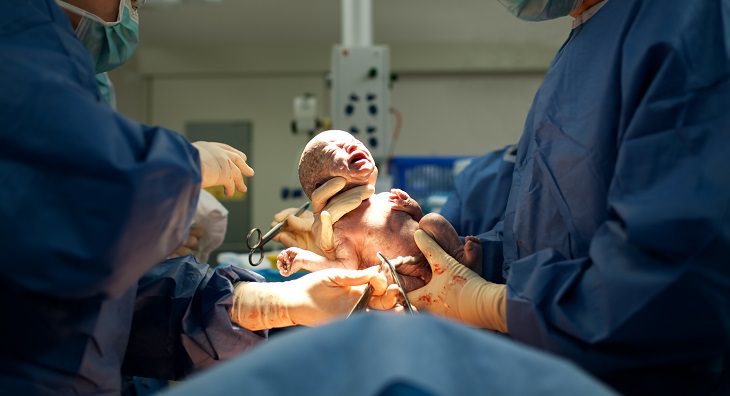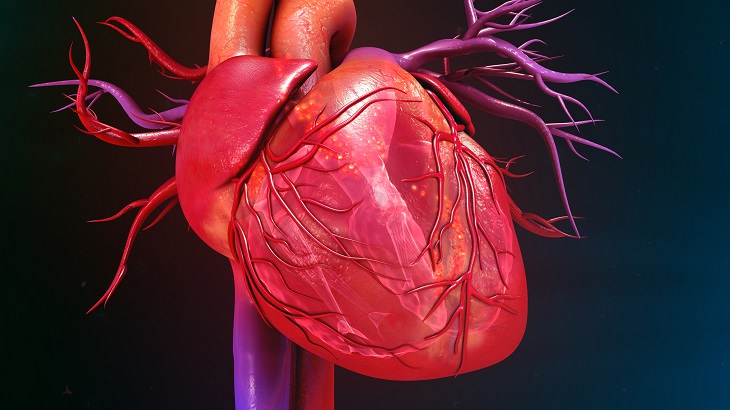
Remarkable and unfathomable phenomena have been observed throughout the course of human history – phenomena which can only be described as miracles. Surprisingly, a large percentage of the human population believes in the concept of miracles, but rarely are these occurrences discussed in public. However, just because we cannot come up with a sound scientific theory to explain these happenings, it does not mean that they don’t exist.
Below are five examples of miracles that have been observed in the field of medicine.

It’s difficult to say what was in worse shape: the run-down century-old church or the cancer-stricken 56-year-old man sat on its crumbling steps. For many years, Greg Thomas would sit on these steps and pray when he walked his dogs along the country lanes in rural Minnesota. However, in May 2009, he found out that the searing earaches, headaches, and jaw aches that had plagued him for 12 months were due to inoperable head and neck cancer. In fact, it had progressed so far that doctors had told Greg’s family to plan his funeral.
Greg was sitting on the church steps one evening when he decided he would like to do one last thing for the Lord. This something was to fix the peeling paint, the leaking roof, the mangled steps, and the rotting floorboards. He approached the church’s association with a deal: He would repair the building if he got a key to the front door so that he could go in and worship whenever he liked. He warned them that it would be slow going as he had just undergone three rounds of chemotherapy along with 40 sessions of radiation. They agreed to his deal anyway.
Incredibly, as Greg scraped off old paint and replaced boards, he felt himself growing stronger each day. The more he worked, the better he felt – he didn’t even need to use the strong prescription drugs that his doctor had prescribed to him.
As Greg continued to fix the church, medical scans revealed some shocking, but very good, news: His tumors were shrinking. Four years and 23 days after his diagnosis, doctors were able to remove his feeding tube – the one they said he would have for the rest of his life. Today, Greg’s tumors are completely gone. He is now in remission and no longer needs any follow-up tests.
And the church? After five years of Greg’s labor and love, it has been restored to it past glory. Greg finished his main project this summer, but he will always be involved in maintaining its beauty. Greg believes that while he was restoring the church, God was restoring him.

The silent killer. This is what doctors call an abdominal aortic aneurysm (AAA).
The extremely dangerous condition – in which the main blood vessel that takes blood to the abdomen, pelvis, and leg enlarges – can balloon up for years without symptoms. However, when it bursts, it’s often fatal.
Pretending to have this silent killer was Jim Malloy’s assignment as a “medical actor” one day in February 2013. Over the years, he had faked all manner of medical maladies so that students at the University of Virginia School of Medicine could practice diagnosing him. This was just some fun for the 75-year-old retired engineer.
When Ryan Jones, a third-year medical student, walked into the room, Jim followed his script: He complained of lightheadedness and stomach pain. However, when Ryan pushed down on the center of Jim’s abdomen, he was shocked to feel a pulsing mass – it appeared to be an actual aneurysm.
Ryan’s attending physician told Jim that he needs to go and see a cardiologist, but it was hard for Jim to take anyone seriously. He felt totally fine and had gotten a clean bill of health from his doctor just two weeks earlier.
He gave in and went to get an ultrasound done. This revealed that his AAA measure six centimeters – with the potential to rupture. He was immediately scheduled for surgery and had a stent inflated to deflate the aneurysm. This ultimately ended up saving his life.

“Fight like a girl.” That’s what the parents of 12-year-old Kali Hardig had told her on Friday, July 19, 2013.
There was nothing else they could say to her. It was impossible to believe that just a day before her crushing headaches and relentless nausea started, Kali and her friends had been having fun at a water park near Benton, Arkansas. It was there, according to doctors, where Kali must have gotten infected with a brain-eating amoeba up her nose.
The creature then traveled up her olfactory nerve and into her brain, where it started feasting on her brain tissue – a condition known as Primary Amoebic Meningoencephalitis. The doctors warned her parents that the condition is about 99% fatal – only two people in the whole of North America had ever survived it.
Still, doctors at Arkansas Children’s Hospital jumped into action, pumping the little girl’s body full of antifungals and antibiotics as well as a rare, unapproved German drug they got from the CDC; decreasing her body temperature to 93 degrees and putting her in a medically induced coma in an attempt to reduce brain swelling.; and hooking her up to a ventilator, then a dialysis machine for her failing kidneys.
For a fortnight, Kali’s medical team worked around the clock just trying to keep her alive – a complex balance of preventing low blood pressure and stopping episodes of high blood pressure that would have worsened brain swelling.
Slowly, Kali’s brain swelling stabilized. Doctors decided to decrease her sedation and increased her body temperature, unsure if she would be the same girl when – or if – she woke up. Nobody knew what the outcome would be, but just two days later, Kali gave everyone the thumbs up.
Kali had to stay in hospital for eight weeks, relearning the most basic of functions, such as swallowing. However, eventually, she officially became survivor number three.

Forty-year-old Ruby Graupera-Cassimiro had just had a C-section. However, when her medical team was moving her to the recovery room, she fell unconscious. Suddenly, Ruby, now a mother of two, was going into full cardiac arrest.
Jordan Knurr, MD, her anesthesiologist at Boca Raton Regional Hospital in Florida, immediately intubated Ruby so that a machine could breathe for her. He called a code, and a dozen other doctors and nurses rushed into the room, frantically giving advanced cardiac life support.
For more than two hours, she was having life-threatening heartbeats. Her heart was beating but it wasn’t pumping any blood throughout her body, and doctors delivered constant CPR compressions for 45 minutes to try and get her heart working normally again.
After about two hours, her doctors realized there was no hope left. They brought her family into the room so that they could say their goodbyes. After her family returned to the waiting room, where they, along with some nurses, prayed on their knees for a different outcome, the doctors stopped pumping her chest. They were ready to write down the time of death.
Dr. Knurr was seconds away from turning off the life-support machine when one of the other nurses shouted at him to stop. Ruby’s heart had started to beat on its own again for the first time in two hours.
It turned out that some amniotic fluid had leaked into the uterus and traveled through her blood into her heart. Known as an amniotic embolism, this causes an air block in the heart and prevents blood from flowing. This condition is rare, and the usual outcome is severe brain damage or death.
The next day, Ruby’s breathing tube was removed. Four days later, she walked out of the hospital with her newborn daughter, with not even a broken rib from all the chest compressions.

On August 17, 2012, 23-year-old Michael Crowe “froze up” – eyes open and staring into space. He quickly snapped back, but when it occurred again a few minutes later, his mother rushed him to the hospital.
There they were informed that Michael was in real trouble. His heart was pumping out blood at just 25%, an alarmingly low rate. By the time he had been transferred to Nebraska Medical Center in Omaha an hour later, it was down to just 10%. A virus in Michael’s body was causing acute myocarditis, inflammation of the heart muscle. If it got much worse, he would need to undergo a heart transplant.
With Michael’s family surrounding his bed, the doctors asked him to sign papers – while he was still able – for that transplant. Despite what was happening to him, Michael remained calm, but his doctors were not.
The rate of mortality for the condition Michael had is huge. They immediately hooked him up to an EMCO, an external heart and lung machine, so blood could at least be pumped around his body. However, this is just a short-term fix and his condition was deteriorating. Spiking fevers led to convulsions; ice cooled him but dropped his oxygen levels. There was an epic struggle to keep him stable.
Michael desperately needed a heart transplant. For 17 days they waited, while his condition continued to worsen. His heart actually stopped beating twice – once for a whole day. Doctors had to battle to prevent blood clots and excess bleeding.
At 6.30 in the morning on Labor Day, Michael’s doctors got the call they had all been waiting for: A heart would be available later that night. However, a few hours later, they made a devastating discovery – Michael had developed a blood infection and doing the transplant would be too dangerous.
As Michael’s family despaired, Dr. Raichlin noticed something unusual: His blood pressure, which should have remained constant because of the machine he was attached to, was actually rising. She ordered a test, which revealed that the left side of his heart was working at near-normal capacity. Not believing these results could be possible, she ordered the test to be retaken. Again, she was given the same outstanding results.
After four days attached to a different machine that only assisted the right side of his heart, Michael no longer needed a transplant. His heart had completely, miraculously healed itself.
Many patients with Michael’s condition die, or get a heart transplant, or survive but have permanent tissue damage. But today, as he works his way through his third year of pharmacy school, his heart is perfectly fine.
Source: rd
Images: depositphotos